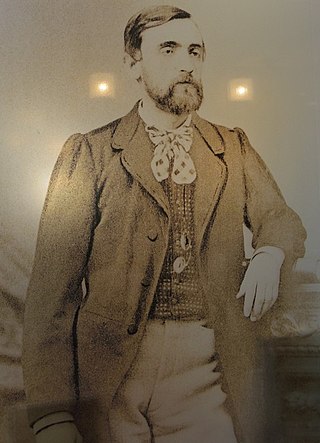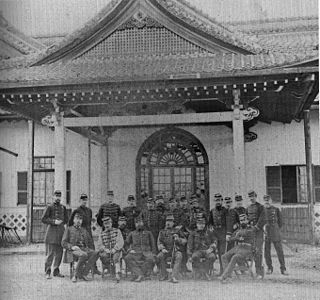
The foreign relations of Japan are handled by the Ministry of Foreign Affairs of Japan.

Bakumatsu was the final years of the Edo period when the Tokugawa shogunate ended. Between 1853 and 1867, under foreign diplomatic and military pressure, Japan ended its isolationist foreign policy known as sakoku and changed from a feudal Tokugawa shogunate to the modern empire of the Meiji government. The major ideological-political divide during this period was between the pro-imperial nationalists called ishin shishi and the shogunate forces, which included the elite shinsengumi swordsmen.

Yokosuka is a city in Kanagawa Prefecture, Japan.
The foreign employees in Meiji Japan, known in Japanese as O-yatoi Gaikokujin, were hired by the Japanese government and municipalities for their specialized knowledge and skill to assist in the modernization of the Meiji period. The term came from Yatoi, was politely applied for hired foreigner as O-yatoi gaikokujin.

François Léonce Verny, was a French officer and naval engineer who directed the construction of the Yokosuka Naval Arsenal in Japan, as well as many related modern infrastructure projects from 1865 to 1876, thus helping jump-start Japan's modernization.

United States Fleet Activities Yokosuka or Commander Fleet Activities Yokosuka is a United States Navy base in Yokosuka, Japan. Its mission is to maintain and operate base facilities for the logistic, recreational, administrative support and service of the U.S. Naval Forces Japan, Seventh Fleet and other operating forces assigned in the Western Pacific. CFAY is the largest strategically important U.S. naval installation in the western Pacific.

Louis-Émile Bertin was a French naval engineer, one of the foremost of his time, and a proponent of the "Jeune École" philosophy of using light, but powerfully armed warships instead of large battleships.

Jean Marlin (1833–1872) was a non-commissioned officer, a sergeant of the French 8th Battalion of infantry. He was a member of the first French military mission to Japan in 1867, in which he accompanied Jules Brunet. He worked as an instructor for infantry in the army of the Tokugawa shogunate.

The French military mission of 1867 to 1868 was one of the first foreign military training missions to Japan, and the first sent by France. It was formed by emperor Napoléon III following a request from the Tokugawa shogunate through its emissary to Europe, Shibata Takenaka, with the goal of modernizing the Japanese military.

Jules Brunet was a French military officer who served the Tokugawa shogunate during the Boshin War in Japan. Originally sent to Japan as a horse artillery instructor with the French military mission of 1867, he refused to leave the country after the shōgun was defeated, and played a leading role in the separatist Republic of Ezo and its fight against forces of the Meiji Restoration. After the rebellion's defeat, he returned to France, fought in the Franco-Prussian War, later reached the rank of general of division, and worked for the Ministry of War.

The 1872–1880 French military mission to Japan was the second French military mission to that country and the first sent by the Third Republic. It followed the first French military mission to Japan (1867–68), which had ended with the Boshin War and the establishment of the rule of Emperor Meiji.

The development of France–Japan relations in the 19th century coincided with Japan's opening to the Western world, following two centuries of seclusion under the "Sakoku" system and France's expansionist policy in Asia. The two countries became very important partners from the second half of the 19th century in the military, economic, legal and artistic fields. The Bakufu modernized its army through the assistance of French military missions, and Japan later relied on France for several aspects of its modernization, particularly the development of a shipbuilding industry during the early years of the Imperial Japanese Navy, and the development of a legal code. France also derived part of its modern artistic inspiration from Japanese art, essentially through Japonism and its influence on Impressionism, and almost completely relied on Japan for its prosperous silk industry.

Canada and Japan have an amicable companionship in many areas. Diplomatic relations between both countries officially began in 1928 with the opening of the Japanese consulate in Ottawa. In 1929, Canada opened its Tokyo legation, the first in Asia; and in that same year, Japan its Ottawa consulate to legation form.

France–Thailand relations cover a period from the 16th century until modern times. Relations started in earnest during the reign of Louis XIV of France with numerous reciprocal embassies and a major attempt by France to Christianize the Kingdom of Thailand and establish a French protectorate, which failed when the country revolted against foreign intrusions in 1688. France would only return more than a century and a half later as a modernised colonial power, engaging in a struggle for territory and influence against Thailand in mainland Southeast Asia that would last until the 20th century.

Japan–Uruguay relations are foreign relations between Japan and Uruguay. Both countries are members of the United Nations and the World Trade Organization.

Cambodia–Japan relations are foreign relations between Cambodia and Japan. Japan has an embassy in Phnom Penh and Cambodia has an embassy in Tokyo.

Belgium–Japan relations are the bilateral relations between the nations of Belgium and Japan. Belgium has an embassy in Tokyo and five honorary consulates in Sapporo, Nagoya, Kyoto, Osaka, and Fukuoka. Japan has an embassy in Brussels.

The nations of Japan and Mexico first established formal diplomatic relations in 1888 with the signing of the Treaty of Amity, Commerce, and Navigation between both nations. This agreement was Japan's first "equal" treaty with any country; which overshadows Tokugawa Ieyasu's pre-Edo period initiatives which sought to establish official relations with New Spain in Mexico.

Historic and current bilateral relationship exist between Bahrain and Japan. Diplomatic relations were first established in 1972, and since then they have had increasing economic, cultural, and military cooperation, with Japan becoming one of the major trading partners of Bahrain. Several high-level official visits have taken place, including by King Hamad bin Isa Al Khalifa to Japan in 2012, Crown Prince Salman in 2013, and Prime Minister Shinzo Abe to Bahrain in 2013, with the governments of both countries expressing their intent to continue to increase their bilateral relations.

Ecuador–Japan relations are the diplomatic relations between Ecuador and Japan. Both nations are members of the Forum of East Asia–Latin America Cooperation.




























